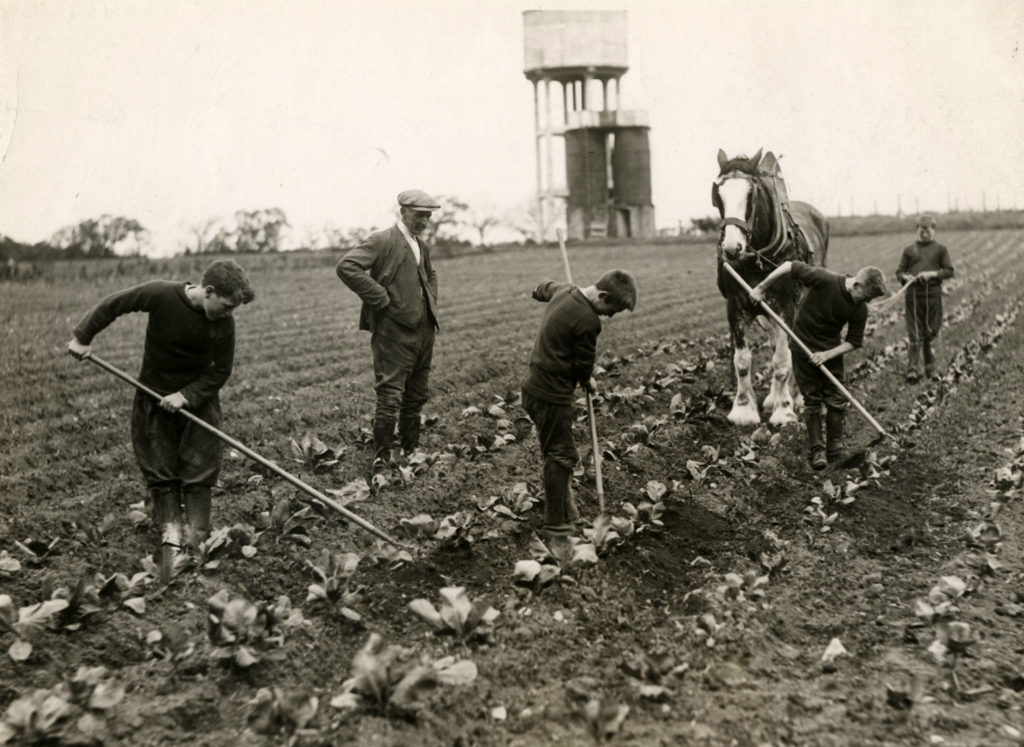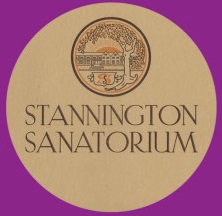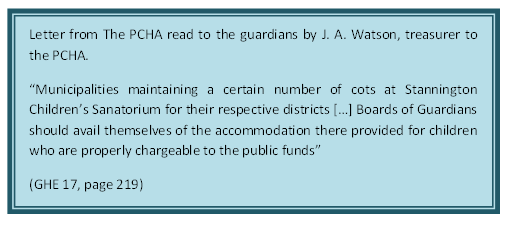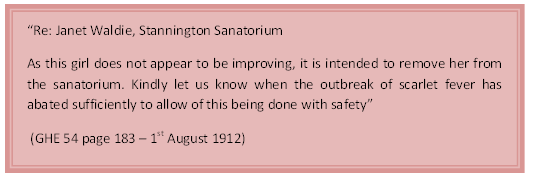Before the NHS supported children at Stannington Sanatorium there were a few sources of finance for patients who could not fund their own places. We have already covered a little of the practice of donations for memorial cots in our online exhibition. From 1929 the Northumberland County Council’s Public Assistance Committee supported places for children from the county, with other councils doing likewise. However what about the children who went to Stannington before 1929?
Before the Committee was created those on low incomes were supported by the Poor Law Boards. They ran the workhouses, provided out-relief to those on low incomes, housed the orphans of the parish, and financially supported the ‘lunatics’ of the parish in the County Asylum (see our recent post). There were ten Poor law unions in Northumberland; Alnwick, Belford, Bellingham, Berwick, Castle Ward (for the Ponteland area), Glendale (for the Wooler area), Haltwhistle, Hexham, Morpeth and Rothbury. We decided to look through our poor law records for children who were supported at Stannington by the Board of Guardians, who dealt with the welfare of individuals, for Hexham Union.
Though Stannington Sanatorium had been open since 1907 the first mention we find in the records isn’t until 1910, when in the minute books we have an explanation of how the system worked:
As the Board of Guardians were not charged for the Stannington patients we do not know how many of the children were sent, but we have a few cases where their return is mentioned.
Though we do not know what became of Janet, the Guardian’s minute book (GHE/20) shows by 1930 Catherine was at the Convent of Notre Dame, Southwark, London. The Sisters of Notre Dame de Namur ran, and continue to run, numerous schools and pupil teacher centres like Southwark across Britain. It is possible that Catherine was training as a pupil teacher, a five year apprenticeship in which girls received lessons as well as teaching younger girls (if you would like to learn more the Sisters have a very informative website). The Guardians sent Catherine £14 11s 9d in National Savings Certificates they had held for her, which were to be kept by her Sister Superior until she turned 21.

However patients at the Sanatorium were not the only children that the Board financed at Stannington. The Philipson Farm Colony was used as a training facility to prepare boys to go into agricultural jobs. The first we see to be sent from Hexham is an orphaned boy, 14 years 5 months old, called William Young.
We first hear of William’s story in a letter in February 1911 to the PCHA, in which the guardians ask for a place at the Philipson Farm Colony for William. Further letters show this was granted, the Guardians agreed to pay six shillings in maintenance for him, and he was to be sent on the 11th March or the 1st of April. The 1911 census, taken on the 2nd April, shows he was a farm labourer, one of many boys in their late teens and early twenties present at the colony, and was born in Brampton, Cumberland. Sadly we have been unable to discover which of the many William Youngs born in the area he might have been.
The Farm Manager at this time was John Atkin, who had leased the farm since 1900 and was in charge of the boys at the colony from its opening in 1905. An article written by John in the Rotary Wheel magazine of August 1918 describes his endeavour to produce the most from the land in as diverse a way as possible, advocating a mixture of crops, livestock and poultry. William would therefore have learned many different aspects of farming at the Philipson Farm Colony.
In March 1913 the Guardians began to debate his next step, likely at the request of the PCHA or Farm Colony, and on the 4th April they had agreed for William to go to Canada. At the time emigration to the British colonies was encouraged, and it was a common thing that boys from the colony would make a new life there using their farming skills. The Guardians requested reassurance of William’s willingness to go and the suitability of the place he would be sent to. It seems this place fell through, and another letter on the 20th of September announced that the Board agreed to his being sent to Australia. However by the 18th of October the plan had again changed to South Africa. He was sent money for clothing, and we know from later correspondence he departed the next day. It seems however William did not enjoy his time there – he wrote to his sister in Hexham, and the letters were passed on to the Guardians and the Farm Colony for them to look at. A letter dated the 29th May 1914 writes to the PCHA that the Boarding Out Committee had decided:
John Nicholas Hall was another boy sent to the Philipson Farm Colony by the Hexham Board of Guardians. A letter on the 26th June 1912 shows they had considered John emigrating to Canada with William, however he went to the Farm Colony instead, again at the same rate of 6/- weekly. All we know from his time there is a brief mention in the minute books. On the 29th April 1913 we find:
These examples give us a little insight into the arrivals at Stannington Sanatorium and the Philipson Farm Colony in their early years, but also into the end of the Poor Law Unions. Though perhaps not the most caring of organisations (such as their reference to Catherine as ‘it’!) the Poor Law Boards sought to find a home and training for a future career for all the children that came to them. They also made sure that children who were unwell were cared for, including within their own institutions. However William’s case also makes us wonder about the stories of the children associated with Stannington and the Farm Colony. We know many other boys from the Farm Colony also emigrated and it is possible this was under the ‘Home Children’ scheme. The scheme started in the 19th century and led to the emigration of many thousands of children from the United Kingdom to Australia, Canada, New Zealand and South Africa. Until relatively recently it has been difficult to find information about these children, but now records have become more accessible via national initiatives. The websites of The National Archives of the UK, Australia, Canada and New Zealand provide useful advice about researching child migration. Sadly there is nothing for South Africa yet, but hopefully we will be able to learn what became of William with further research.






